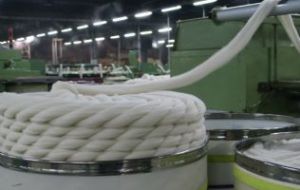MercoPress. South Atlantic News Agency
Wool prices suffer considerable tumble in September but still above a year ago
 Chinese processors increasingly nervous with current rates for raw wool
Chinese processors increasingly nervous with current rates for raw wool Wool prices suffered a considerable tumble during September in line with the bearish market for commodities as a result of global economic uncertainty, although values are still considerably higher than a year ago.
Following Tuesday’s sales the Eastern Market Indicator was down 4%, at 11.20 dollars per kilo, which represents a 17.2% drop compared to the end of August. The EMI is back where it was in late January but compared to a year ago, 8.58 per kilo is still 30.5% higher.
“Retail demand appears still to be strong for wool, but many early-stage Chinese processors were becoming increasingly nervous about paying current rates for raw wool” said a wool operator in Australia.
Growers or vendors reacted last week by passing in 7800 bales, or 18.1% of the 42.800 bale offering. In Melbourne on Thursday the pass in rate rose to 21%.
Industry consultant Peter Morgan said he believed the market was reacting to the global financial uncertainties.
“Three weeks ago it appeared prices might have been steadying, but in the meantime the financial markets had continued to fall,” Morgan said.
Michell Direct operations manager Steven Read said he believed many processors were waiting to see where the market levelled out.
However, Elders national wool centre manager Simon Hogan said there were positive signs on Friday when Elders sold 50 lots, which had been passed in the previous day.
The roller-coaster ride in price over the last 12 months leaves brokers with the quandary of whether to advise their clients to sell or not.
Superfine wools have been the most affected. An 18-micron, 190kg fleece wool bale that would have sold for 1627 dollars a year ago was making 2140 last week, which is 1000 less than its March peak. Whereas 21-micron wool bales were selling 430 dollars more than this time last year.
“The decision is always left to the vendor, although we do point out that today's prices were still well above what they would have received this time last year,” Mr Hogan said.

![“Working directly with President [Donald] Trump and Congress, we accomplished what no one else could,” Patel stressed](/data/cache/noticias/108417/130x80/fbi.jpg)


Top Comments
Disclaimer & comment rulesCommenting for this story is now closed.
If you have a Facebook account, become a fan and comment on our Facebook Page!